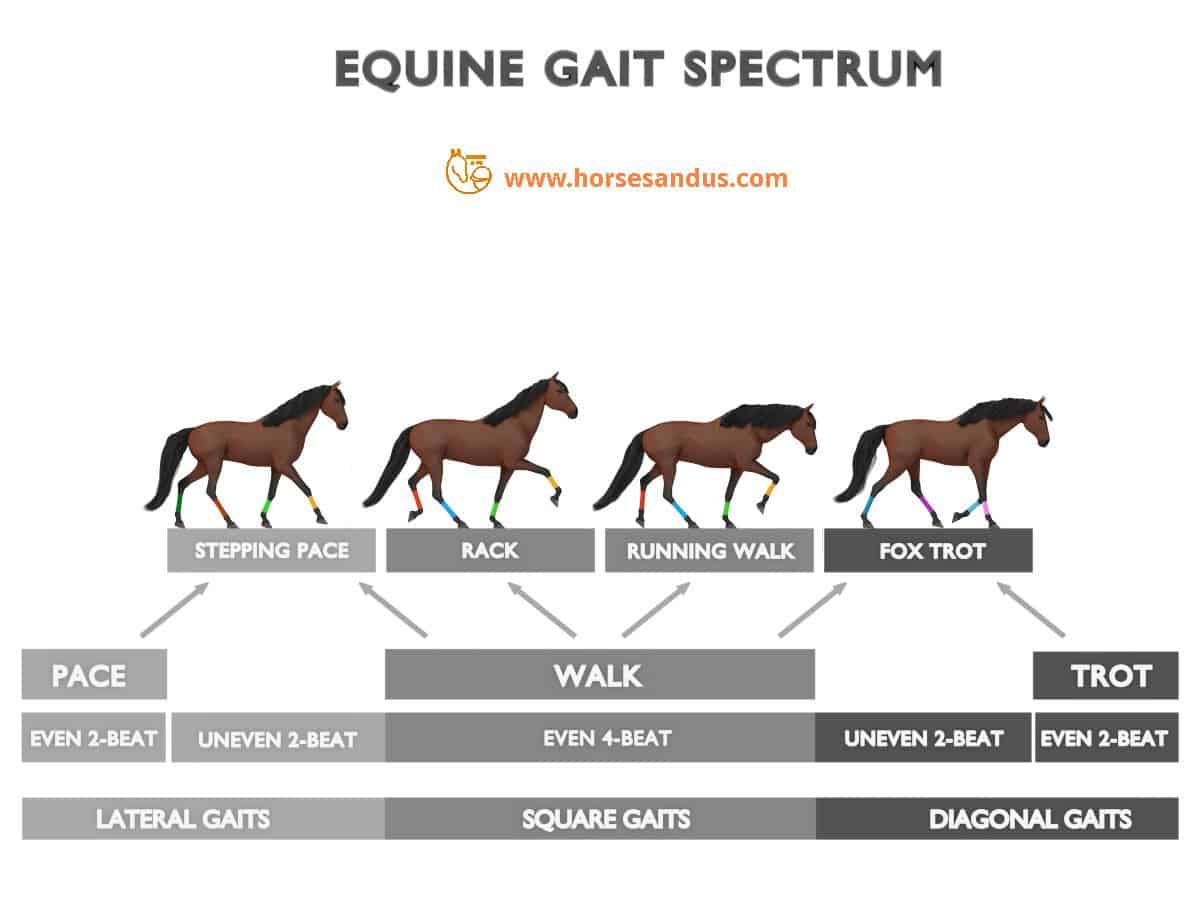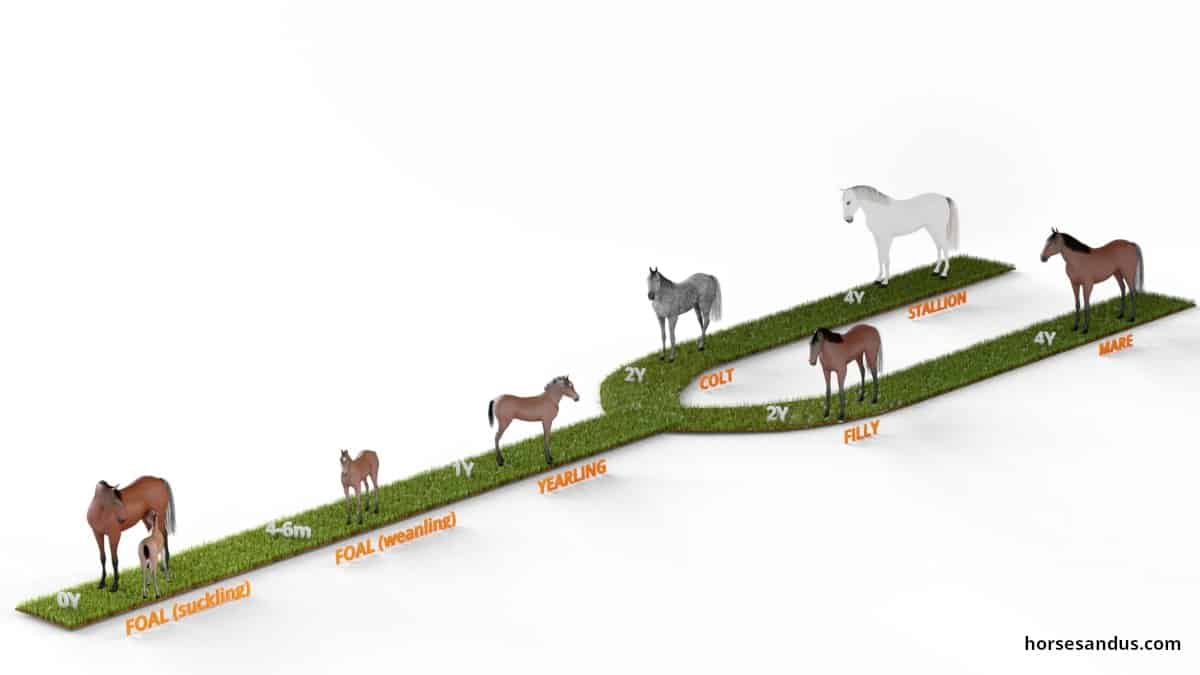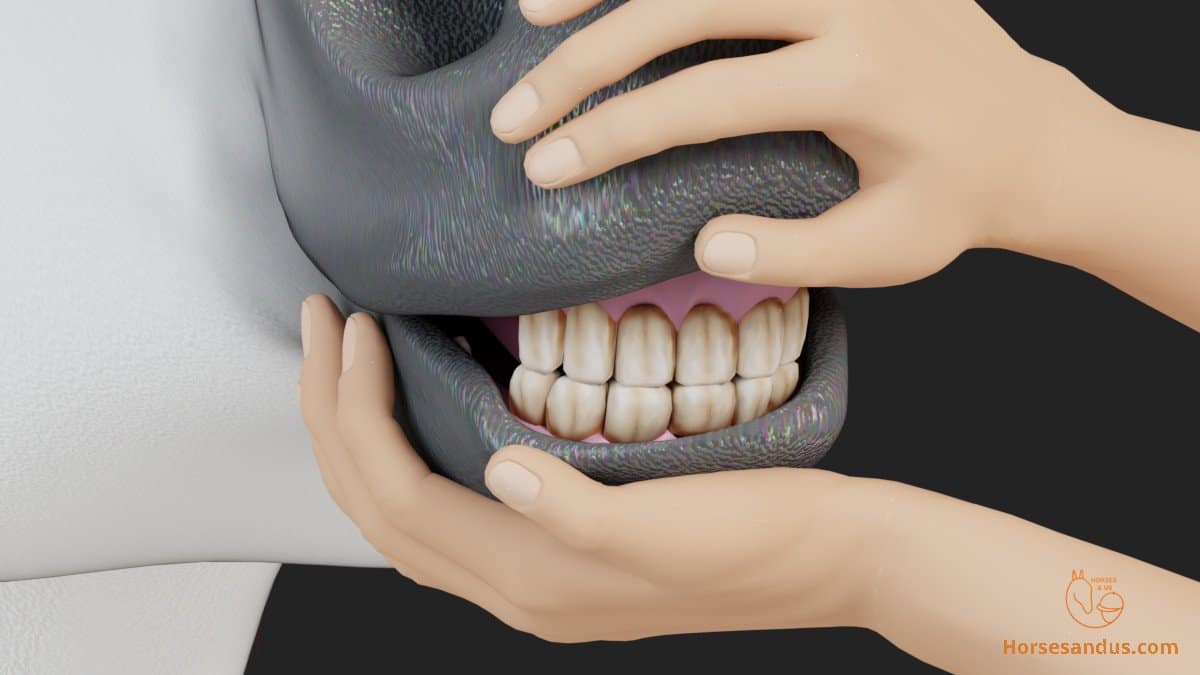A horse reaches 97% of its mature height around 2 years, but the equine skeletal maturity with the fusion of all growth plates will only be achieved when the horse is around six years old.
The horse’s skeletal development is done from the bottom up. The lower bones will fuse first and the higher bones last.
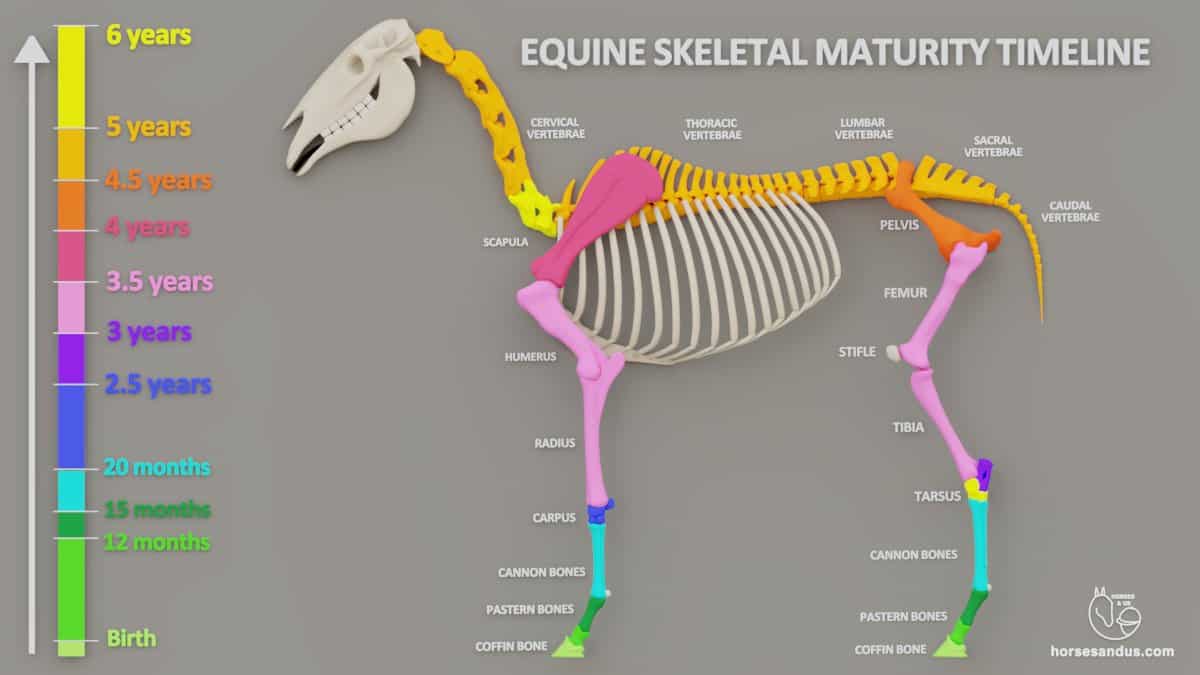
The decision to train and ride our horse should be based on the equine skeletal development timing rather than its size and external appearance. If exercise is too intense for the horse’s skeletal maturity stage, then developmental orthopedic disease can occur.
The slow rate of equine skeletal development applies to all horses. However, while small feral mares may be physically mature at 5.5 years old, healthy domestic horses will only mature when they are 6. Tall, long-necked horses may take even longer (source).
Equine Growth Plates Chart
Every horse´s bone behind the skull has a growth plate on either end. In some bones like the pelvis or vertebrae, there are multiple growth plates. Within the spine, there are over 80 growth plates.
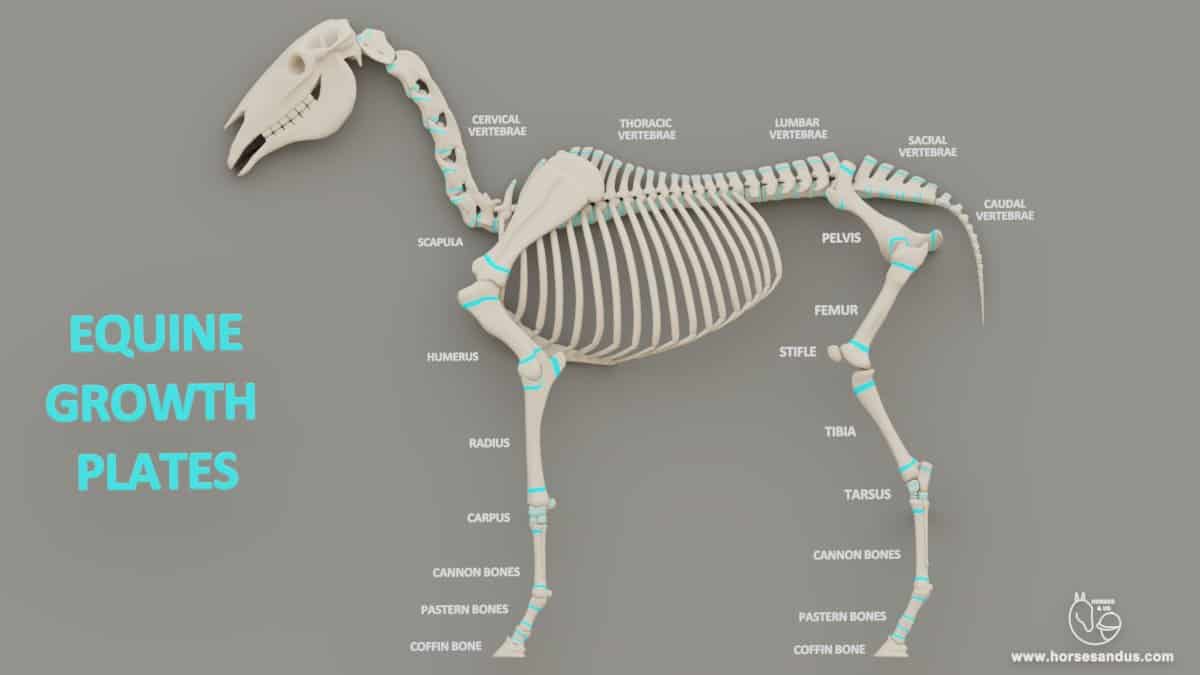
The growth plate of the coffin bone is already closed at birth (which means it won’t get any taller, although it will become much larger). The growth plate closure on the other bones will follow until the horse is approximately 6 years old.
Horse Bone Growth Chart Animation
This short video will walk you through the timeline of equine skeletal development.
Equine Growth Plate Closure Table
| BONE | GROWTH PLATE | AGE OF CLOSURE |
|---|---|---|
| Coffin bones | Coffin bone | Before birth |
| Distal (bottom) | Before birth | |
| Proximal (top) | 9 – 12 months | |
| Long Pastern Bones | Distal (bottom) | Before birth |
| Proximal (top) | 13 – 15 months | |
| Cannon bones | Distal (bottom) | 16 – 20 months |
| Proximal (top) | Before birth | |
| Carpus (knee) | carpus bones | 1.5 – 2.5 years |
| Radius + Ulna (fused) | Distal (bottom) | 2.5 – 3.5 years |
| Proximal (top) | 1.5 – 2 years | |
| Ulna olecranon | 2.5 – 3.5 years | |
| Humerus | Distal (bottom) | 15 – 18 months |
| Proximal (top) | 3 – 3.5 years | |
| Scapula | Scapula | 3.5 – 4 years |
| Tarsus (hock) | tarsus bones | 4 – 6 years |
| Point of hock | Calcaneus | 3 years |
| Tibia | Distal (bottom) | 1.5 – 2 years |
| Proximal (top) | 3 – 3.5 years | |
| Femur | Distal (bottom) | 2.5 to 3.5 years |
| 3rd trochanter | 2.5 – 3 years | |
| Proximal (top) | 2.5 – 3 years | |
| Pelvis | Hip Socket | 1.5 – 2 years |
| Pelvis tubers | 3 – 4.5 years | |
| Spine | Vertebrae cranial border | 3 – 5 years |
| Vertebrae caudal border | 5 years or more | |
| Vertebrae (base of the neck) | Last to close | |
| Tip of spinous process | 4 – 5 years |
This information was taken from the book: Posture and Performance Principles of training horses from the Anatomical perspective, Gillian Higgins with Stephanie Martin.
This is a great book with information about anatomy and biomechanics that every rider should know. You can purchase it from amazon here.
Equine Bone Development
There are two types of bones in the horse which have different development mechanisms:
- Flat bones of the skull are developed by intramembranous ossification
- All other bones are developed by endochondral ossification
We will focus on the development of these other bones because of their impact on the stability of the horse and how this can be influenced by diet and training plans.
The Structure of a Bone
Looking at a long bone, like for example the cannon bone, we can observe the following:
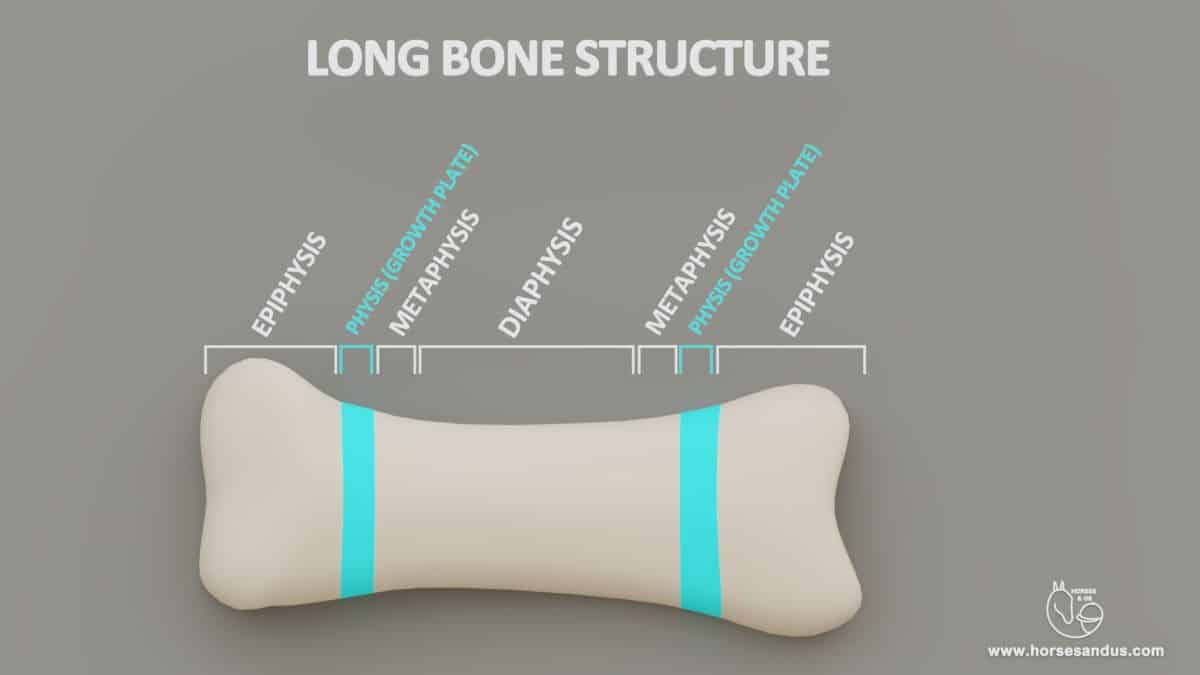
- The Diaphysis is the shaft of the bone made of compact bone tissue enclosing the medullary cavity. It is cylindrical and flares outward near the end to form the metaphysis.
- The Metaphysis is the portion of the bone between the Epiphysis and Diaphysis.
- The Physis (growth plate) comprises cartilage and is a line between the epiphysis and the metaphysis.
- The Epiphysis, the wide extremity at the end of the bone made of spongy bone tissue. It forms a joint with the neighboring bone.
The Bone Growth Process
During the equine skeletal development, the bones will continue to grow at the extremities, where growth plates are located. The bone reaches its maturity when the growth plate is closed, and the Epiphysis fuses with the Diaphysis
Within the growth plate, a complex process is going on. Cartilage is being produced and continuously changing into bone tissue, causing the bone to lengthen.
This process happens in five different zones. Four in the growth plate and one in the metaphysis.
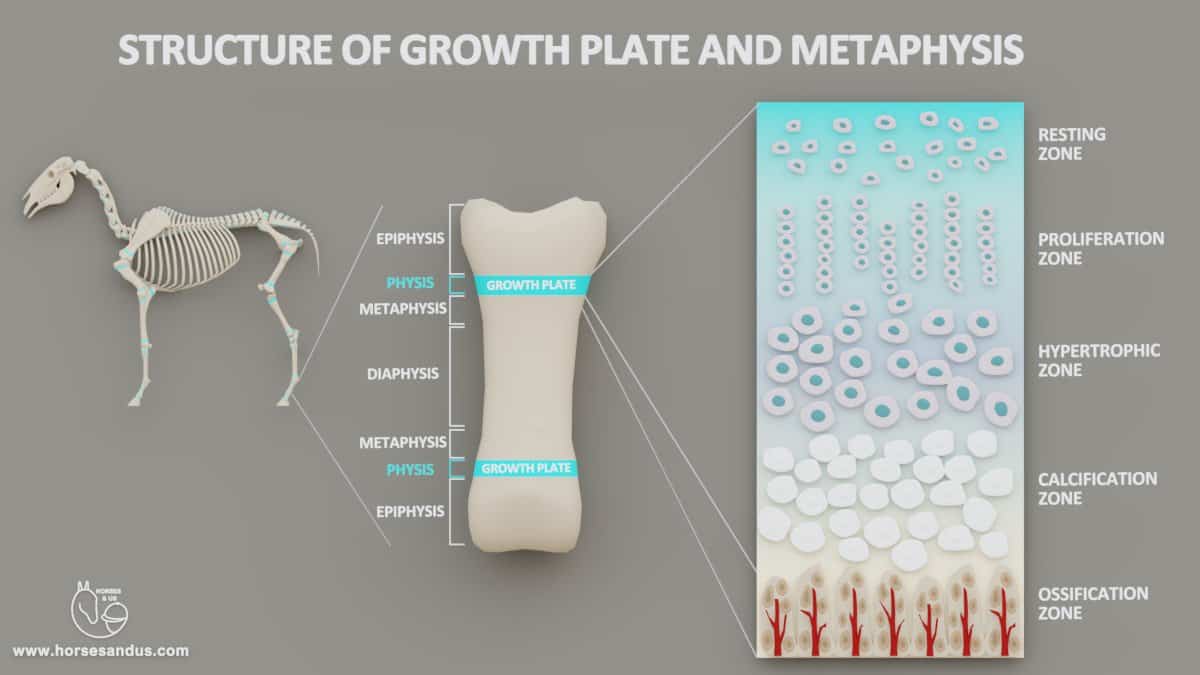
1- Closest to the epiphysis is the Resting or Reserve zone. In this zone, the cartilage cells (chondrocytes) are relatively inactive.
2- Proliferation zone. In this zone, the cartilage cells proliferate by rapidly dividing and stacking on top of each other, resembling stacks of coins. This stacking of cells in columns causes the epiphysis to push away from the diaphysis, resulting in the lengthening of the bone.
Between these stacks is a supporting material, referred to as matrix, produced by the cartilage cells.
3- Maturation or hypertrophic zone is where the cartilage cells stop dividing and start to enlarge and mature. They will signal the surrounding cartilage matrix to harden and calcify.
4- Calcification Zone. In this zone, the cartilage cells are dying and start to calcify.
5- Already in the area of the metaphysis is the Ossification Zone. This zone is invaded by blood vessels, osteoclasts, and osteoblasts. The osteoclasts break down the calcified cartilage while osteoblasts replace it with new bone tissue.
Even after the bone reaches its maturity with the closure of the growth plate, the bone can continue to increase in diameter throughout the horse’s life in response to stress from exercise. This increase in bone diameter is called appositional growth.
What Age Do Horses Reach Full Height
The age at which horses reach full height will vary greatly among different breeds. In general, most horses reach their full height around 5 years of age, but some horses can take as long as 8 years. The growth rate is fastest during the first 2 years, slowing down after that age.
The bones that mostly determine the horse’s height (cannon, tibia, femur, scapula) will generally stop growing around 4 years of age. But some bones that still add to the horse’s height, such as the spine tips at the withers, will continue to grow until 5 or 6 years of age.
The majority of horse breeds are born with 60% of their full height and have more than 90% by age 2. The following picture illustrates this growth rate based on studies for an average light horse.

The horse’s skeletal maturity lags behind its height appearance. Although a horse grows very quickly, having an almost adult height at 2 years of age, its skeletal maturity is only achieved around 5 years of age.
The only way to truly know if a horse has stopped growing and reached its skeletal maturity is through x-rays to observe if the growth plates are already closed.
You can roughly estimate the adult height by taking some measurements of the foal, using the string test and cannon bone. In our article about baby horses, we explain how you can do this.
Besides the breed, other factors, such as genetics and nutrition, can impact the horse’s growth rate and, therefore, the age a horse will reach its full height.
The effect of genetics and nutrition on rapid growth rates can lead to developmental orthopedic disease in young horses.
The Effect of Exercise during Equine skeletal development
The horse is a very precocious animal, already on its feet within one hour after birth. Within a few more hours, it is already running in short spurts.
However, when young horses are still growing, especially during the first three years of life, their immature bones and tendons are not as strong as those of an adult horse.
People worry about exercising young horses because it may cause damage to their tendons and bones, which are still under development. But it depends on the amount of exercise. The right amount will be beneficial, but too much will cause damage.
Research (here and here) has shown that an appropriate amount of exercise may be beneficial because it builds stronger bones and more resistant tendons.
However, too much exercise can cause damage and lead to developmental orthopedic disease.
So you may ask how much exercise is too much. Unfortunately, research does not yet have enough data to draw conclusions. You need to use your good common sense.
Conditioning young foals
For conditioning foals, it is preferable to leave them out in the pasture instead of having them confined in stalls. But very large pastures can lead the foal to perform excessive exercise to keep up with the mare and cause damage to bones and muscles.
Training young horses
When it comes to training young horses, you should consider the skeletal maturity schedule when preparing your training plan.
The exercise should start slow and easy to allow the musculoskeletal tissues to adapt and then gradually increase the workload so the horse can progressively become more fit. If we overload the horse with too much exercise too quickly, serious damage can occur before the horse has time to become fit.
Riding a horse should ideally be delayed until 4 years and must be done with moderation because the horse’s back is not mature until 5 to 6 years.
The Effect of Nutrition during Equine skeletal development
Growing horses require specific nutrients to develop a good foundational musculoskeletal structure. The nutrition the foal receives right from the beginning can profoundly affect its soundness for the rest of its life.
In the Beginning its is all about the Mare’s Nutrition
When thinking about nutrition for a growing horse, we must not forget that it starts even before it is born.
The nutrition of the mare during the last three months of pregnancy has a significant impact on the foal’s healthy growth. A great amount of development has taken place before the foal is born. At birth, it is already 60% of its mature height and 10% of its mature weight.
After the foal is born, its growth still depends on the mare´s nutrition. During the first three months, the foal´s main nutrition source is the mare’s milk. So our main focus should still be on the mare.
Around 3 months the Foal’s Nutrition is Supplemented with Foal Feed
Around three months, the mare´s milk production will start to decline, not only in quantity but also in nutrient content. So by this time, it is important to start also focusing on the foal.
At three months, and still, while the foal is lactating, it should also have access to a nutritionally balanced foal feed. This should not be delayed until weaning.
Excess vs Deficient Nutrients
Providing the correct nutrition to your young horse while its skeleton is developing, is a careful balancing act.
You want to provide enough nutrients to produce a strong, healthy horse that can grow to its full potential but not too much. Excessive energy in the diet can cause rapid growth in too little time, leading to skeletal problems.
On the other hand, too little energy and a lack of required nutrients can hinder bone growth. It can also lead to compensatory growth later when nutrients are available, which causes excessive growth in a short time, resulting in skeletal problems, as mentioned above.
